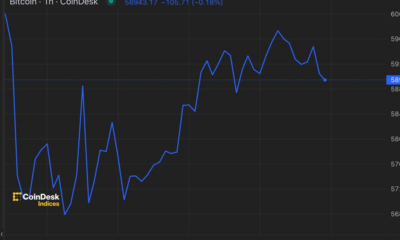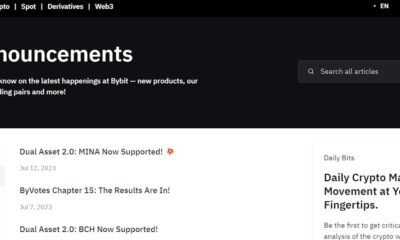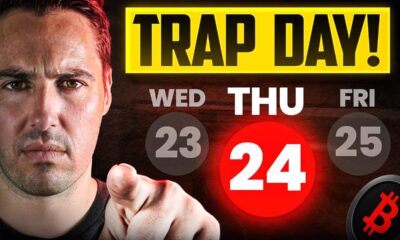News
The Rise Of Crypto’s Billion Dollar Zombies

With bitcoin soaring once again, blockchains are suddenly much more valuable. More than 50 of them are now worth over $1 billion—despite many having few users.
By Steven Ehrlich, Maria Gracia Santillana Linares and Nina Bambysheva, Forbes Staff
In 2012 when Blockchain pioneers Jed McCaleb, Arthur Britto and David Schwartz created Ripple Labs and its new cryptocurrency, known as XRP, they envisioned a new global financial standard that would enable banks to transfer money rapidly with minimal fees. During its first decade, dozens of financial institutions, including Bank of America and Banco Santander, signed up, eager to test Ripple’s new network. To fund their ambitious project, executives at the company created 100 billion XRP tokens and sold $1.4 billion worth to the public. In early 2018, at the height of the first wave of crypto euphoria, XRP was trading with a market value of $132 billion, giving cofounder and executive chairman Chris Larsen a net worth of $8 billion.
In terms of global money flows, not much is going on at Ripple Labs today, and few expect it ever to disrupt the Belgian banking cooperative known as SWIFT, which facilitates $5 trillion in interbank transfers every day. Despite failing at its primary mission, Ripple’s blockchain, a ledger of XRP transactions, continues to hum along. It’s largely useless, but the XRP token still sports a market value of $36 billion, making it the sixth-most valuable cryptocurrency. Larsen remains a billionaire, worth an estimated $3.2 billion. Last year, Ripple’s XRP ledger earned a mere $583,000 in fees processing transactions across its network, according to Messari. In Wall Street parlance, that would give XRP a “price-to-sales” ratio of 61,689. Nvidia, the market’s hottest stock, with a market capitalization above $2 trillion and revenue of $61 billion, has a price-to-sales ratio of 37.
Ripple Labs is a crypto zombie. Its XRP tokens continue to trade actively, some $2 billion worth per day, but to no purpose other than speculation. Not only is SWIFT still going strong, but there are now better ways to send payments internationally via blockchains, especially stablecoins like tether, which is pegged to the U.S. dollar and has $100 billion in circulation.
Ripple is not alone. A Forbes investigation reveals that even though only a handful of blockchains other than Bitcoin and Ethereum have gained significant traction, there are no fewer than 50 blockchains today trading at values of more than $1 billion, of which at least 20 are functional zombies. In the wake of the SEC’s approval of spot bitcoin ETFs, crypto markets are soaring. The 20 blockchains Forbes analyzed, whose quixotic ambitions range from a universal world computer to an untraceable payments network, have a combined market value of $116 billion. Most have few users.
But don’t expect XRP or any of these crypto creations to shutter operations anytime soon. With billions sitting in their coffers, Ripple and others can continue to exist for years. Ripple currently has $24 billion worth of XRP tokens in escrow that it can sell over the next four years. Currently, the San Francisco company has 900 employees and continues to issue press releases for things like its recent acquisition of digital asset custody operation Standard Custody & Trust. After more than a decade in existence, it is still running pilot crypto programs with central banks in places like the nation of Georgia and the South Pacific Republic of Palau.
“It’s like early-stage venture capital funds or companies that raise too much money and don’t know how to adequately deploy it,” says Matt Hougan, CIO of Bitwise Asset Management. “There’s no way to return the treasury to the investors.”
Moreover, in the bizarro world of digital assets, rich zombie blockchains need not worry about the kinds of things that keep traditional companies on their toes. There are no shareholders or regulators asking for financial statements, and short selling tokens is relatively difficult. So long as there is an ample supply of speculators willing to trade the tokens, flush zombie blockchains will continue to roam the digital landscape.
Says one venture capitalist who requested anonymity, “There’s no wind-down process for a dead crypto protocol.”
GOOD-FOR-NOTHING BLOCKCHAINS
The 20 blockchains below command a total market value of more than $100 billion despite the fact that they are unproven and have little utility other than for speculative crypto trading. Most have treasuries brimming with millions, but they answer to neither shareholders nor regulators.
(SCROLL RIGHT TO SEE THE FULL TABLE)
ZOMBIE BLOCKCHAINS mostly fall into two categories: They are either spin-offs of earlier blockchains like Bitcoin and Ethereum or direct competitors to them. Spin-off (a.k.a. “hard fork”) zombies include Bitcoin Cash, Litecoin, Monero, Bitcoin SV and Ethereum Classic. These five blockchains collectively trade at a valuation of $23 billion today. They are largely the result of disagreements between programmers over how Bitcoin or Ethereum should be run. Because the code underlying these blockchains is open source, anyone can repurpose it for any reason. When the coders can’t get along, a group of them will split off and create a new network, a schism known as a hard fork. Each time a new chain is created this way, it shares the same history as the original chain. And like stock spin-offs, this means that all token holders at the time of the fork receive the same number of tokens on the new chain that they own on the original.
Litecoin was an early Bitcoin fork. It launched in 2011 as a faster, cheaper version for sending payments. It produces blocks four times faster than Bitcoin, an average of one every 2.5 minutes against every 10 minutes for Bitcoin. Like Bitcoin, it processes transactions via proof of work, meaning lots of computers are spinning their wheels (and burning electricity) solving pointless mathematical equations. Also like Bitcoin, it has a hard limit on its token supply, 84 million versus Bitcoin’s 21 million. Today Litecoin has a market capitalization of $6.5 billion, but last year it booked just $389,000 in fees, compared to $800 million for Bitcoin. Blockchain users pay fees to miners as an incentive for them to process their transactions in the next block they create. The fees generated by zombie blockchains like Litecoin are minimal, indicating a lack of demand for the platform. These blockchains also have trouble attracting developers. As of the end of 2023 there were only 74 monthly active open-source developers supporting Litecoin, according to Electric Capital’s Developer Report, compared to more than 1,000 for Bitcoin and 7,000-plus for Ethereum.
Bitcoin Cash is worth even more than Litecoin, with a market cap of $7.9 billion, yet it has only 30 monthly active developers supporting it and $49,000 in 2023 fee revenue. Bitcoin Cash was born after an acrimonious split with Bitcoin in 2017 over whether to increase Bitcoin’s block size. The fight was arcane. Essentially, Bitcoin Cash supporters thought the crypto should be primarily useful as a medium of exchange (in other words, you should be able to buy things with it), while the rest of the community wanted to prioritize the store of value function, or the ability to save it for future use.
Bitcoin SV—for “Satoshi Vision”—is even more controversial, given that it’s fronted by Craig Wright, an Australian computer scientist who dubiously claims to be Satoshi Nakamoto, the pseudonymous Bitcoin inventor. “I created Bitcoin,” he told Forbes in an interview in 2023. The U.K.’s High Court disagreed in March, ruling that the evidence is “overwhelming” that Wright did not write the initial Bitcoin whitepaper, is not Satoshi Nakamoto and did not create the “Bitcoin system.” Bitcoin SV was delisted by Coinbase in January but still maintains a market value of $1.6 billion.
Among blockchain zombies, Ethereum Classic (ETC) holds the unique distinction that it actually is the original Ethereum chain. What is widely known as Ethereum today is in reality a fork of ETC, created in 2016 to recover $60 million in stolen ether (worth $11.5 billion based on today’s prices). A significant minority of Ethereum backers worried about the moral hazard implications of altering the history of the ledger to recover funds, and they decided to continue maintaining ETC as the original and unaltered code base. One of the blockchain’s biggest backers is Connecticut firm Grayscale Investments, the world’s largest crypto asset manager, whose ex-billionaire founder, Barry Silbert, is an outspoken ETC bull. Ethereum Classic has a market value of $4.6 billion but generated fees of less than $41,000 in 2023.
Of the five spin-off blockchains Forbes analyzed, none of the crypto industry insiders or data analysis firms we consulted could cite any serious uses for these platforms except for simply trading their tokens.
“What’s keeping these zombies alive is liquidity,” says one VC. “Litecoin was one of the first tokens that Coinbase supported back in the day. A lot of people owned litecoin.”
Adds Bob Summerwill, executive director at the Ethereum Classic Cooperative, “ETC is listed nearly everywhere because of its history, which turns into quite a lot of trading volume. Much of the activity is speculative.”
Riding ethereum’s coattails, ethereum classic tokens are trading 31% higher than they did a year ago, compared to a 77% gain for ether. Bitcoin Cash has outpaced bitcoin, which hit a record high in mid-March after a 121% surge in the last 12 months. Bitcoin Cash is up 164% over the same period.
THE BIGGEST GROUP of zombies are would-be challengers to Ethereum. They mostly claim to be technological improvements on Vitalik Buterin’s 2014 creation, because Ethereum can process only a dozen transactions per second and is prone to sky-high fees during peak use. Tezos, founded later in 2014, was one of the first chains to incorporate a process known as proof-of-stake—as opposed to proof-of-work—to create new tokens. The details are bewildering (and vary by crypto project), but proof-of-stake is favored by many crypto enthusiasts because it does not require the same electricity-wasting computing power as bitcoin mining.
Tezos raised $230 million in a 2017 initial coin offering (ICO), and the current market capitalization for its XTZ token is $1.2 billion. However, it has been processing about 130,000 transactions daily, compared to 1.2 million for Ethereum, and it has just $66 million in so-called total value locked (TVL) in digital assets on its network. For blockchains like Ethereum, which are designed to host applications ranging from crypto exchanges to video games and NFTs, TVL is widely used as a measure of health. Ethereum, with more than 4,500 apps, has a TVL of $48 billion.
In terms of processing or “baker” fees, as Tezos users refer to them, $5,640 was earned in February 2024 and $177,653 for all of 2023. Arthur Breitman, who founded Tezos with his wife, Kathleen, insists that dramatically understates the actual total. According to Breitman, 75% of the total fees paid to the network take the form of XTZ tokens which are typically taken out of circulation—or “burned”—and thus are not counted in its published fee figures. Breitman estimates Tezos has $700 million in its treasury and maintains that only 20% of its funds are held in the XTZ token. “There’s a bunch of bitcoin, and then the rest is a diversified stock-and-bond portfolio,” he says.
That’s impossible to verify. The blockchain’s development is funded by a nonprofit called the Tezos Foundation, which is based in Switzerland. Its stated mission is the “promotion of the Tezos protocol through grants and other capital deployment vehicles.” In the first half of 2023, the Tezos Foundation awarded as much as $18 million to 31 new grantees. Grant recipients included a Philadelphia video game company building Tezos-compatible puzzles and a Singaporean talent agency specializing in digital art.
Then there is Algorand, which has a market cap of $2 billion and $500 million in its treasury. Once regarded as an “Ethereum killer” because of its reported ability to process 7,500 transactions per second, it brought in only $63,000 in blockchain transaction fees in 2023. “Their technology is probably right there with the other chains, but they’re not seeing much activity because they don’t have much community and talent beyond their founder [renowned Italian computer scientist and MIT professor Silvio Micali],” says one prominent crypto strategist.
Counters Eric Wragge, who runs business development for the Singapore-based Algorand Foundation: “We’re in that Uber mode—it lost money on every single person who got into a car.” They are also losing executives at a rapid clip. Over the last two years, the Algorand Foundation hired a new CEO and overhauled its entire C-suite.
Some blockchain zombies seem to trade solely based on the popularity of their creators. Cardano, another Ethereum competitor, was launched in 2017 after its cofounder, Charles Hoskinson, had a falling-out with Buterin, his Ethereum cofounder. Hoskinson’s blockchain is worth an astounding $23 billion with a TVL of $396 million. It brought in $3 million in fees last year, despite the Cardano Foundation itself saying it hasn’t yet completed its developmental stages.
Hoskinson himself seems to be the main attraction. He owns an 11,000-acre ranch in Wyoming, funds self-described alien hunters and recently opened an anti-aging and regenerative medicine center in the town of Gillette. He is not always a reliable narrator. He claimed to have dropped out of a math Ph.D. program at the University of Colorado, Boulder, but the school says Hoskinson was an undergrad who didn’t complete his degree. He has hinted for years about working for Darpa, the Pentagon’s prestigious research division. But he does reliably tout Cardano to his 980,000 followers on X.
Asks Bitwise’s Matt Hougan, “Is it a pre-revenue blockchain still building out its architecture, or is it just a future pilot that will never materialize?”
THE 20 ZOMBIE blockchains called out on our table are just the largest examples of digital assets trading without any regard for the utility or viability of their underlying projects. There are many more roaming about. According to CoinGecko, more than 13,000 cryptocurrencies are listed on various exchanges, most having the characteristics of speculative penny stocks, except they don’t represent ownership in anything at all. Thanks to bitcoin’s surge, the total value of all crypto is around $2.5 trillion today.
Seems like an excellent shorting opportunity, but according to crypto trading firms, it’s difficult to bet against zombie blockchain tokens because it’s not easy to borrow significant amounts of the underlying tokens for short selling. Moreover, given crypto’s history of irrational and volatile trading, it’s extremely risky. Any token has the potential to transform into a memecoin based on nothing more substantial than a late-night tweet from Elon Musk.
Take the case of Ethereum Classic. In August 2020, when it was trading at around $6 per token, it faced three so-called 51% attacks in a single month. This occurs when a single token holder controls more than half of a network’s computing power, used to create blocks and therefore “govern” the platform. Had they been permanent (they were not), these “hostile takeovers” could have allowed the blockchain’s supposedly immutable ledger to be altered. In other words, anyone who owns 51% of a blockchain could undo previously settled transactions or mint unlimited tokens for himself. Despite being exposed as unsafe three times in a month, Ethereum Classic shrugged off its death blows in the summer of 2020 and today trades at $31.
The Department of Justice and the Securities and Exchange Commission’s approach to cracking down on crypto fraud and theft has been to go after large crypto exchanges—the enablers. FTX has been shuttered and its founder, Sam Bankman-Fried, is in jail. Binance’s founder, Changpeng Zhao, has been kicked out of the business, his exchange forced to pay $4.3 billion last year after he pleaded guilty to anti–money laundering and sanctions violations.
Two other large exchanges, Coinbase and Kraken, have each been sued by the SEC for acting as unregistered securities brokers and exchanges. Several zombie blockchain tokens, including cardano and algorand, were cited as being examples of securities in disguise.
Can token holders access the billions in capital being stored in the “treasuries” of the blockchain zombies? Unfortunately, it’s probably out of reach. “There would need to be a cause of action and actual harm from something like fraud,” says Yesha Yadav, associate dean at Vanderbilt University Law School, noting that past cases have been split on whether decentralized organizations or foundations can be held liable.
In September 2022, the feds sued the participants of a decentralized autonomous organization called Ooki DAO, alleging that it was selling unregistered commodity futures. In June, a California court ordered the organization to pay a fine of $644,000. That money is supposed to come out of its “decentralized” treasury, but the government is still awaiting payment. Two months later, a federal judge in New York dismissed a lawsuit filed against decentralized crypto exchange Uniswap, ruling that there was no centralized entity to serve as an “identifiable defendant.”
Don’t expect any of the cash-rich, do-nothing blockchains to shut down anytime soon. They are busy spending their money on long-shot projects. In March, the Stellar Development Foundation, the nonprofit presiding over zombie Stellar’s $2.5 billion treasury, announced it would invest $100 million in companies planning to use its new smart contract platform as it seeks to diversify beyond its mostly nonexistent payments business.
Buyer beware. The lunatics are running the crypto asylum.
MORE FROM FORBES
ForbesThis Deep-Sea Mining Company Will Sweep The Ocean Floor For Battery Materials-If It Doesn’t Go Broke FirstBy ForbesMeet The Man Trying To Fill The Shoes Of Billionaire Legend Sam ZellBy ForbesWhy The World’s Top Travel Brands Are Betting Big On Indian TouristsBy ForbesHere’s Why The Kushners Are Unlikely To Help Pay Trump’s BondBy ForbesHow Elon Musk’s Buddy Rode Tesla Shares To Become A BillionaireBy
News
Ether Drops Further After ETF Launch

Key points
- Spot ether ETFs began trading in the U.S. today, with the funds initially having more than $10 billion in collective assets under management.
- Analysts expect the launch of spot ether ETFs to have a net negative impact on the underlying price of ether in the near term, due to expected outflows from the pre-existing Grayscale Ethereum Trust.
- Spot Bitcoin ETFs continue to see strong inflows, with BlackRock’s IBIT alone seeing more than $500 million in inflows on Monday.
- Franklin Templeton, a spot ETF issuer on bitcoin and ether, has invested in a project that intends to bring Ethereum technology to Bitcoin.
Nine-point ether exchange-traded funds (ETFs)) started trading on the stock market on Tuesday, but all the optimism ahead of their approval did not translate into gains for the cryptocurrency markets.
Ether (ETH), the native cryptocurrency of the Ethereum blockchain, dropped less than 1% around the $3,400 level as of 1:30 PM ET, while Bitcoin (BTC) fell more than 2% to around $66,000.
Ether ETFs’ Debut Isn’t as Flashy as Bitcoin ETFs’
Spot ether ETFs began trading at just over $10 billion assets under management (AUM)), according to Bloomberg Intelligence analyst James Seyffart, most of that money is in the current Grayscale Ethereum Trust (ETHE) which has now been converted into an ETF.
“In the long term, Grayscale will simultaneously have the highest and lowest fees in the market. The asset manager’s decision to keep its ETHE fee at 2.5% could lead to outflows from the fund,” Kaiko Research said in a note on Monday.
Outflows from ETHE, if they occur, would be similar to those faced by Grayscale’s Bitcoin Trust (GBTC) after spot bitcoin ETFs began trading in January of this year, most likely due to high fees for the two original funds. Grayscale’s existing fund charges 2.5% fees, while a new “mini” ether ETF will charge 0.15% and commissions for other ETFs are set at 0.25% or less.
Such outflows could impact the price of ether and market sentiment.
“There could be a pullback shortly after the launch of Ethereum spot ETFs, i.e. outflows from Grayscale Ether Trust could dampen market sentiment in the short term,” Jupiter Zheng, a partner at Hashkey Capital’s liquid fund, told The Block.
But Grayscale remains optimistic.
“Compared to the splashy debut of spot bitcoin ETPs in January, the launch of ethereum ETPs has been relatively muted,” said Zach Pandl, Grayscale’s head of research, adding that investors may be “undervaluing” ether ETFs that are “coming to the U.S. market in tandem with a shift in U.S. cryptocurrency policy and the adoption of tokenization by major financial institutions.”
Bitcoin ETF Inflows Continue to Rise
As for bitcoin, there is clearly no lack of demand for spot ETFs, such as BlackRock’s iShares Bitcoin Trust (IBITS) recorded its sixth-largest day of inflows in its short history on Monday, at $526.7 million, according to data from Farside Investors. Daily inflows for the overall spot bitcoin ETF market also hit their highest level since June 5.
In particular, asset manager Franklin Templeton, which has issued both bitcoin and ether ETFs, appears to have decided to cover its back when it comes to Ethereum by investing in Bitlayer, a way to implement Ethereum technology on a second-layer Bitcoin network, according to CoinDesk.
News
Spot Ether ETFs Start Trading Today: Here’s What You Need to Know

Key points
- Spot ether ETFs will begin trading on U.S. exchanges on Tuesday. Nine ETFs will trade on Cboe BZX, Nasdaq and NYSE Arca.
- Ether ETFs offer investors exposure to the price of their underlying assets.
- Commissions on these new ETFs generally range from 0.15% to 0.25%.
- These ETFs do not provide exposure to Ethereum staking.
The U.S. Securities and Exchange Commission (SEC) has officially approved nine ether spots (ETH)exchange-traded funds (ETFs) for trading on U.S. exchanges. Trading for these new cryptocurrency investment vehicles begins today. Here’s everything you need to know.
What new ether ETFs are starting to trade today?
Spot ether ETFs starting trading today can be found at Quotation, NYSE Arkand Cboe BZX. Here’s a breakdown of each ETF you can find on these three exchanges, along with the fund tickers:
Cboe BZX will list the Invesco Galaxy Ethereum ETF (QETH), the 21Shares Core Ethereum ETF (CETH), the Fidelity Ethereum Fund (FETH), the Franklin Ethereum ETF (EZET) and the VanEck Ethereum ETF (ETHV).
Nasdaq will have the iShares Ethereum Trust ETF (ETHA) created by BlackRock, which also operates the largest spot bitcoin ETF under the ticker IBIT.
NYSE Arca will list the Bitwise Ethereum ETF (ETHW) and the Grayscale Ethereum Trust (ETHE). The Grayscale Ethereum Mini Trust (ETH), which will begin trading on the same exchange.
How does an ether ETF work?
Spot ether ETFs are intended to offer exposure to the price of ether held by the funds. Ether is the underlying cryptocurrency of the Ethereal network, the second largest crypto network by market capitalization.
ETF buyers are buying shares of funds that hold ether on behalf of their shareholders. Different spot ether ETFs use different data sources when it comes to setting the price of ether. Grayscale Ethereum Trust, for example, uses the CoinDesk Ether Price Index.
None of the ETFs launching today include pointed etherwhich represents a potential opportunity cost associated with choosing an ETF over other options such as self-custody or a traditional cryptocurrency exchange.
Ether staking currently has an annual return of 3.32%, according to the Compass Staking Yield Reference Index Ethereum. However, it is possible that the SEC will eventually approve Ether staking held by ETFs.
How can I trade Ether ETFs?
ETFs can simplify the trading process for investors. In the case of cryptocurrencies, instead of taking full custody of the ether and taking care of your own private keysSpot ether ETFs allow investors to purchase the cryptocurrency underlying the Ethereum network through traditional brokerage accounts.
Today, not all brokers may offer their clients spot ETFs on cryptocurrencies.
What are the fees for ether ETFs?
The fees associated with each individual spot ether ETF were previously revealed In the S-1 OR S-3 (depending on the specific ETF) deposit associated with the offerings. These fees are 0.25% or less for all but one.
The Grayscale Ethereum Trust, which converts to an ETF, has a fee of 2.5%. The Grayscale Mini Ethereum Trust has the lowest fee at 0.15%. These fees are charged on an annual basis for the provider’s management of the fund and are in line with what was previously seen with spot bitcoin ETFs.
Brokers may also charge their own fees for cryptocurrency trading.
News
Kamala Harris Odds Surge Amid $81M Fundraise. What Does It Mean for Bitcoin and Cryptocurrencies?

Market odds and memecoins related to US Vice President Kamala Harris have soared as the latest round of donations tied to the Democratic campaign raised $81 million in 24 hours, bolstering sentiment among some traders.
The odds of Harris being declared the Democratic nominee have risen further to 90% on cryptocurrency betting app Polymarket, up from 80% on Monday and setting a new high.
Previously, in early July, bettors were only betting on 8%, but that changed on Saturday when incumbent President Joe Biden announced he would no longer run in the November election. Biden then approved Harris as a candidate.
Polymarket traders placed $28.6 million in bets in favor of Harris, the data showsThe second favorite is Michelle Obama.
Somewhere else, Memecoin KAMA based on Solanaa political meme token modeled after Harris, has jumped 62% to set a new all-time high of 2 cents at a market cap of $27 million. The token is up a whopping 4,000% from its June 18 low of $0.00061, buoyed primarily by the possibility of Harris becoming president.
As such, Harris has yet to publicly comment on cryptocurrencies or her strategy for the growing market. On the other hand, Republican candidate Donald Trump has expressed support for the cryptocurrency market and is expected to appear at the Bitcoin 2024 conference on Saturday.
However, some expect Harris or the Democratic Party to mention the sector in the coming weeks, which could impact price action.
“While he has not yet received the official nomination, there is consensus that last night’s development is in line with current Democratic strategy,” cryptocurrency trading firm Wintermute said in a Monday note emailed to CoinDesk. “Keep an eye on Democrats’ comments on this issue in the coming days.
“The prevailing assumption is that Harris will win the nomination and any deviation from this expectation could cause market volatility,” the firm added.
News
Top 30x Cryptocurrency and Coin Presales Today: Artemis Coin at #1, Others Are: BlockDAG, 99Bitcoin, eTukTuk, and WienerAI

The cryptocurrency market has seen a lot of growth and imagination lately, with new ventures popping up regularly. A critical pattern in this space is the rise of crypto pre-sales, which give backers the opportunity to get involved with promising projects early on. Artemis is a standout option for crypto investors looking to expand their portfolios amid the many pre-sales currently underway.
Cryptocurrency presales, commonly referred to as initial coin offerings (ICOs), allow blockchain ventures to raise capital by offering their local tokens to early backers before they become available on open exchanges. Investors can take advantage of these presales by purchasing tokens at a lower price. If the project is successful and the token’s value increases, investors stand to receive significant returns.
>>> Explore the best cryptocurrency pre-sales to buy now <<
The Ultimate List of the Top 5 Cryptocurrency Pre-Sales to Invest In
- Artemis: The aim of Artemis (ARTMS) will become the cryptocurrency equivalent of eBay or Amazon. The upcoming Phase 4 will see the launch of the Artemis Framework, which will serve as a stage for digital money exchanges where buyers, sellers, specialized organizations and those seeking administration can participate in coherent exchanges.
- DAG Block: uses Directed Acyclic Graph technology to increase blockchain scalability.
- 99bitcoin: operates as a crypto learning platform
- WienerAI uses AI-powered trading bots for precise market analysis.
- eTukTuk focuses on environmentally sustainable transportation options, such as electric vehicle charging infrastructure.
We have determined that Artemis is the best new cryptocurrency presale for investment after conducting extensive research. It presents itself as the unrivaled cryptocurrency presale choice currently open.
>> Visit the best cryptocurrency pre-sale to invest in now <<
Top 5 Crypto Pre-Sales and Best Cryptocurrencies for Investment Today
Artemis (ARTMS) is attempting to establish itself as the cryptocurrency version of eBay or Amazon. The Artemis Crypto System, which will act as a platform for cryptocurrency transactions, will be launched in Phase 4. Buyers, sellers, service providers, and requesters will all benefit from seamless trading with this system. Customers will be able to purchase things, such as mobile phones using digital money, as well as sell products such as involved bicycles and get paid in cryptocurrency. Additionally, crypto money can be used to pay for administrations such as clinical consultations, legitimate care, and freelance work. Artemis Coin will act as the main currency of the ecosystem, with Bitcoin and other well-known cryptocurrencies from various blockchain networks backing it.
Artemis Coin has increased in price from 0.00055 to 0.00101 from 0.00094. Artemis may be attractive to individuals looking to recoup losses in Bitcoin, as predicted by cryptocurrency analysts. At this point, it seems to present an interesting presale opportunity.
>>> Visit the best cryptocurrency pre-sale to invest in now <<
The world of digital currency pre-sales is an exciting and exciting opportunity that could open the door to game-changing blockchain projects. Projects in this article, like Artemis Coin, offer the opportunity to shape the future of various industries and the potential for significant returns as the industry develops.
However, it is imperative to approach these investments with caution, thorough research, portfolio diversification, and awareness of the risks. You can explore the digital currency pre-sale scene with greater certainty and increase your chances of identifying and profiting from the most promising venture opportunities by following the advice and methods in this article.
>>> Join the best cryptocurrency pre-sale to invest in now <<
-

 News1 year ago
News1 year agoBitcoin (BTC) price recovery faces test on non-farm payrolls
-

 Bitcoin12 months ago
Bitcoin12 months ago1 Top Cryptocurrency That Could Surge Over 4,300%, According to This Wall Street Firm
-

 Altcoins12 months ago
Altcoins12 months agoOn-chain data confirms whales are preparing for altcoin surge with increased buy orders
-

 Bitcoin12 months ago
Bitcoin12 months agoThe US government may start accumulating Bitcoin, but how and why?
-

 News1 year ago
News1 year agoNew ByBit Listings for 2024: 10 Potential Listings
-

 News1 year ago
News1 year ago11 Best Crypto TikTok Accounts & Influencers in 2024
-

 Altcoins1 year ago
Altcoins1 year agoMarket giants have taken action!
-

 News1 year ago
News1 year ago11 Best Shitcoins to Buy in 2024: The Full List
-

 Ethereum1 year ago
Ethereum1 year agoTop Meme Coins by Market Capitalization in 2024
-

 News1 year ago
News1 year ago1.08 Trillion SHIBs Dumped on Major Crypto Exchange, What’s Going On?
-

 News1 year ago
News1 year ago19 Best Crypto Games to Play in 2024
-

 Altcoins1 year ago
Altcoins1 year agoAltcoin Recommended by Crypto Expert for Today’s Portfolio












